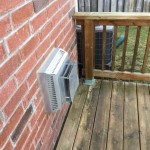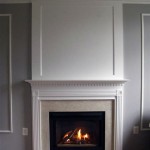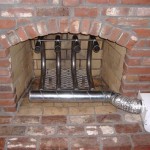```html
Fireplace Or Wood Stove: A Comparative Analysis
The decision between installing a fireplace or a wood stove in a home involves careful consideration of various factors, including heating efficiency, aesthetics, installation requirements, maintenance demands, and environmental impact. Both options offer the warmth and ambiance of a wood-burning fire, but they differ significantly in their performance and overall suitability for different households.
Heating Efficiency and Performance
One of the primary distinctions between fireplaces and wood stoves lies in their heating efficiency. Fireplaces, particularly traditional open-hearth models, are notoriously inefficient heaters. A significant portion of the heat generated by the fire escapes up the chimney, with estimates suggesting that as much as 90% of the heat is lost. This is due to the large flue opening required for proper draft and the lack of a sealed combustion chamber. The radiant heat emitted from the fire provides some warmth to the immediate vicinity, but the overall heating capacity is limited and often results in localized heating rather than effectively warming the entire room or home.
In contrast, wood stoves are designed for significantly higher heating efficiency. They feature a closed combustion chamber and a controlled air intake system, allowing for more complete combustion of the wood and reducing heat loss. Modern wood stoves often achieve efficiency ratings of 70% or higher, meaning that a larger percentage of the heat produced is retained within the living space. Some models incorporate features such as catalytic combustors or secondary air systems to further enhance efficiency and reduce emissions. The improved efficiency of wood stoves translates to lower fuel consumption, reduced heating costs, and a more consistent and even distribution of heat throughout the home.
Furthermore, wood stoves offer greater control over the burning process. Adjustable air vents allow the user to regulate the intensity of the fire and the rate at which the wood burns. This control is essential for maintaining a consistent temperature and maximizing the heating output. Fireplaces, on the other hand, generally offer limited control over the airflow, making it difficult to maintain a steady and efficient burn.
Aesthetics and Ambiance
While wood stoves excel in heating efficiency, fireplaces often hold an advantage in terms of aesthetics and ambiance. The open flame of a fireplace provides a visually appealing focal point for a room, creating a sense of warmth and relaxation. Fireplaces can be designed in a wide variety of styles, from traditional brick or stone hearths to more contemporary and minimalist designs. The crackling sound and flickering light of the fire contribute to a unique and inviting atmosphere.
Wood stoves, although functional and efficient, may not always offer the same level of visual appeal. While some modern wood stoves are designed with aesthetics in mind, they typically prioritize practicality over ornate design. However, the visual appeal of a wood stove can be enhanced by surrounding it with decorative elements, such as a brick or stone facing, or by choosing a model with a large viewing window.
The choice between a fireplace and a wood stove often depends on the individual's priorities. If the primary goal is to create a visually stunning focal point, a fireplace may be the preferred option. If, however, the focus is on maximizing heating efficiency and minimizing fuel consumption, a wood stove is generally the better choice.
Installation and Cost Considerations
The installation requirements and associated costs can vary significantly between fireplaces and wood stoves. Fireplace installation often involves more extensive construction, particularly for traditional masonry fireplaces. A properly constructed chimney is essential for venting the smoke and gases produced by the fire, and this can be a significant expense. Building codes typically dictate specific requirements for chimney height, diameter, and construction materials to ensure safe and efficient operation. The installation of a fireplace may also require modifications to the existing structure of the home, such as reinforcing the floor to support the weight of the hearth and chimney.
Wood stove installation is generally less complex and less expensive than fireplace installation. Wood stoves can be vented using a prefabricated chimney system, which is typically easier and less costly to install than a masonry chimney. However, it is crucial to ensure that the chimney system is properly sized and installed according to the manufacturer's instructions and local building codes. A hearth pad is also required to protect the floor from heat and embers. While the initial cost of a wood stove may be higher than that of a basic fireplace, the lower installation costs and improved heating efficiency can often result in significant long-term savings.
Furthermore, the cost of fuel can vary depending on the availability and price of firewood. In some regions, firewood may be readily available and relatively inexpensive, while in others it may be scarce and costly. The efficiency of the heating appliance also plays a significant role in fuel consumption, with wood stoves typically requiring less firewood than fireplaces to produce the same amount of heat.
Maintenance and Safety
Both fireplaces and wood stoves require regular maintenance to ensure safe and efficient operation. Creosote, a flammable byproduct of burning wood, can accumulate in the chimney and flue, posing a significant fire hazard. Regular chimney sweeping is essential to remove creosote buildup and prevent chimney fires. The frequency of chimney sweeping depends on the type of wood burned, the efficiency of the appliance, and the frequency of use.
Fireplaces require periodic cleaning to remove ashes and soot from the firebox and hearth. The damper should also be inspected to ensure that it is functioning properly. Wood stoves require similar maintenance, including cleaning the firebox, removing ashes, and inspecting the door seals and air vents. The flue pipe connecting the stove to the chimney should also be inspected regularly for signs of corrosion or damage.
Safety is paramount when operating any wood-burning appliance. It is essential to install smoke detectors and carbon monoxide detectors in the home to provide early warning of potential hazards. Fire extinguishers should be readily accessible and properly maintained. Children and pets should be kept a safe distance from the fire, and flammable materials should be stored away from the heating appliance. Proper ventilation is also crucial to prevent the buildup of carbon monoxide. It's always best to consult with certified professionals for installation and safety inspections.
Environmental Impact
The environmental impact of burning wood is a growing concern, particularly in areas with high levels of air pollution. Wood-burning appliances release particulate matter and other pollutants into the air, which can contribute to respiratory problems and other health issues. The amount of pollution emitted depends on the type of appliance, the type of wood burned, and the burning practices.
Modern wood stoves are designed to burn cleaner than older models, thanks to advancements in combustion technology. Many new wood stoves are certified by the Environmental Protection Agency (EPA) to meet stringent emission standards. These stoves incorporate features such as catalytic combustors or secondary air systems to reduce particulate matter emissions. Burning dry, seasoned wood is also crucial for minimizing pollution. Wet or unseasoned wood burns inefficiently and produces significantly more smoke and pollutants.
Fireplaces, particularly older models, tend to be more polluting than wood stoves. The open design and uncontrolled airflow result in incomplete combustion and higher emissions. However, fireplace inserts, which are essentially wood stoves that fit inside an existing fireplace opening, can significantly improve the efficiency and reduce the emissions of a fireplace. The use of manufactured fire logs can also reduce particulate matter emissions compared to burning natural wood, although they are typically more expensive.
```
Fireplace Vs Stoves Pros Cons Dc Service

Wood Stoves Vs Fireplaces Burning Hearth S
Wood Burning Stoves To Heat Your Home And Heart Mansion Global

What S Best A Fireplace Stove Or Insert We Love Fire

Freestanding Wood Burning Stoves Sierra Hearth And Home

Q A Wood Burning Stoves

New Wood Burning Stoves More Efficient Than Masonry Fireplace

Wood Stove Or Fireplace It S No House And Hammer

Most Popular Fireview Soapstone Wood Stove Woodstove

Stoves Wood Gas Pellet Lopi
Related Posts








